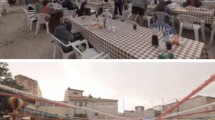Abstract
As the adoption of XR progressively grows across diverse domains, it is paramount to delve into the factors that can affect the user experience while using XR technology. The purpose of this research was to understand the influence of content type, exposure time, and gender on presence and cybersickness within the context of virtual reality experiences. The evaluation was conducted with a sample of 20 participants who were randomly exposed to four content types: a digital game, a simulator, a synthetic cultural environment, and a 360-degree video. No significant changes regarding global presence were observed. However, upon analysing its subdimensions, the values indicate a correlation between content type and both spatial presence and experienced realism. Gender disparities were detected, with male participants considering the digital game less realistic compared to other content types, while female participants scored it on par with the others. Moreover, the total exposure time positively correlated with higher global presence for female participants, with a difference also being observed in terms of experienced realism. Regarding cybersickness, the correlation between gender and total exposure time indicated that female participants reported less cybersickness as exposure time increased. The research conducted, currently entering a second phase in which the same type of content will be tested across different head-mounted displays, has provided relevant results that are already being applied to other studies focused on virtual reality experiences, such as the therapeutic use of the technology by users diagnosed with phobias or neurocognitive disorders.
Access this chapter
Tax calculation will be finalised at checkout
Purchases are for personal use only
Similar content being viewed by others
References
LaValle, S.M.: Virtual Reality. Cambridge University Press (2019)
Frederiksen, J.G., et al.: Cognitive load and performance in immersive virtual reality versus conventional virtual reality simulation training of laparoscopic surgery: a randomized trial. Surg. Endosc. 34, 1244–1252 (2020). https://doi.org/10.1007/s00464-019-06887-8
Harrington, C.M., et al.: 360° operative videos: a randomised cross-over study evaluating attentiveness and information retention. J. Surg. Educ. 75, 993–1000 (2018). https://doi.org/10.1016/j.jsurg.2017.10.010
Reisinho, P., Raposo, R., Zagalo, N., Ribeiro, O.: Interactive Narrative in virtual Reminiscence Therapy to Stimulate Memory and communication in People with Dementia (2024)
Narciso, D., Bessa, M., Melo, M., Coelho, A., Vasconcelos-Raposo, J.: Immersive 360° video user experience: impact of different variables in the sense of presence and cybersickness. Univers. Access Inf. Soc. 18, 77–87 (2017). https://doi.org/10.1007/s10209-017-0581-5
Melo, M., Vasconcelos-Raposo, J., Bessa, M.: Presence and cybersickness in immersive content: effects of content type. Expo. Time Gender. Comput. Graph. 71, 159–165 (2018). https://doi.org/10.1016/j.cag.2017.11.007
Milgram, P., Kishino, F.: Taxonomy of mixed reality visual displays. IEICE Trans. Inf. Syst. 12, 1321–1329 (1994)
Jerald, J.: The VR book: human-centered design for virtual reality. Assoc. Comput. Mach. (2016). https://doi.org/10.1145/2792790.2792814
Azuma, R.T.: A survey of augmented reality. Virtual Augment. Real. 6, 355–385 (1997). https://doi.org/10.1162/pres.1997.6.4.355
Rauschnabel, P.A., Felix, R., Hinsch, C., Shahab, H., Alt, F.: What is XR? Towards a framework for augmented and virtual reality. Comput. Hum. Behav. 133, 107289 (2022). https://doi.org/10.1016/j.chb.2022.107289
Coelho, C., Tichon, J., Hine, T.J., Wallis, G., Riva, G.: Media presence and inner presence: the sense of presence in virtual reality technologies. IOS Press (2006)
Slater, M., Wilbur, S.: A framework for immersive virtual environments (FIVE): speculations on the role of presence in virtual environments. Presence Teleoperators Virtual Environ. 6, 603–616 (1997). https://doi.org/10.1162/pres.1997.6.6.603
Csikszentmihalyi, M.: Flow: The Psychology of Optimal Experience. Harper & Row (1990)
Murray, J.H.: Hamlet on the Holodeck: The Future of Narrative in Cyberspace. The Free Press (1997)
Weech, S., Kenny, S., Barnett-Cowan, M.: Presence and cybersickness in virtual reality are negatively related: a review. Front. Psychol. 10 (2019). https://doi.org/10.3389/fpsyg.2019.00158
Caserman, P., Garcia-Agundez, A., Gámez Zerban, A., Göbel, S.: Cybersickness in current-generation virtual reality head-mounted displays: systematic review and outlook. Virtual Real. 25, 1153–1170 (2021). https://doi.org/10.1007/s10055-021-00513-6
Beat Games: Beat Saber. https://www.oculus.com/experiences/quest/2448060205267927/
Oculus: Mission: ISS. https://www.oculus.com/experiences/quest/2094303753986147/
FSDesign: Talasnal House VR. https://www.meta.com/experiences/5315654131846251/
Reis, F.: S. Gonçalinho VR Experience. https://www.youtube.com/watch?v=TQhS5MEXkwE
Meta: Quest 2. https://store.facebook.com/quest/products/quest-2/
Schubert, T., Friedmann, F., Regenbrecht, H.: The experience of presence: factor analytic insights. Presence Teleoperators Virtual Environ. 10, 266–281 (2001). https://doi.org/10.1162/105474601300343603
Vasconcelos-Raposo, J., et al.: Adaptation and validation of the Igroup presence questionnaire (IPQ) in a Portuguese sample. Presence Teleoperators Virtual Environ. 25, 191–203 (2016). https://doi.org/10.1162/PRES_a_00261
Schubert, T., Friedmann, F., Regenbrecht, H.: Igroup Presence Questionnaire (2016)
Kennedy, R.S., Lane, N.E., Berbaum, K.S., Lilienthal, M.G.: Simulator sickness questionnaire: an enhanced method for quantifying simulator sickness. Int. J. Aviat. Psychol. 3, 203–220 (1993). https://doi.org/10.1207/s15327108ijap0303_3
Kilteni, K., Groten, R., Slater, M.: The sense of embodiment in virtual reality. Presence Teleoperators Virtual Environ. 21, 373–387 (2012). https://doi.org/10.1162/PRES_a_00124
Kelly, J.W., Gilbert, S.B., Dorneich, M.C., Costabile, K.A.: Gender differences in cybersickness: clarifying confusion and identifying paths forward. In: Proceedings - 2023 IEEE Conference on Virtual Reality and 3D User Interfaces Abstracts and Workshops, pp. 283–288 (2023). https://doi.org/10.1109/VRW58643.2023.00067
Dudley, J., Yin, L., Garaj, V., Kristensson, P.O.: Inclusive immersion: a review of efforts to improve accessibility in virtual reality, augmented reality and the metaverse. Virtual Real. 27, 2989–3020 (2023). https://doi.org/10.1007/s10055-023-00850-8
Baker, L., Ventura, J., Langlotz, T., Gul, S., Mills, S., Zollmann, S.: Localization and tracking of stationary users for augmented reality. Vis. Comput. 40, 227–244 (2024). https://doi.org/10.1007/s00371-023-02777-2
Silva, C., Zagalo, N., Vairinhos, M.: Towards participatory activities with augmented reality for cultural heritage: a literature review. Comput. Educ. X Real. 3, 100044 (2023). https://doi.org/10.1016/j.cexr.2023.100044
Reisinho, P., Silva, C., Vairinhos, M., Oliveira, A.P., Zagalo, N.: Tangible interfaces and augmented reality in a nutrition serious game for kids. In: 2021 IEEE 9th International Conference on Serious Games and Applications for Health (SeGAH), pp. 1–8 (2021). https://doi.org/10.1109/SEGAH52098.2021.9551852
Martins, S., Vairinhos, M.: Ludic and narrative immersion in virtual reality exposure therapy to animal phobias: a systematic literature review. Virtual Worlds 2, 303–325 (2023). https://doi.org/10.3390/virtualworlds2040018
Reisinho, P., Raposo, R., Zagalo, N.: A systematic literature review of virtual reality-based reminiscence therapy for people with cognitive impairment or dementia. In: 2022 International Conference on Interactive Media, Smart Systems and Emerging Technologies (IMET), pp. 1–8 (2022). https://doi.org/10.1109/IMET54801.2022.9930000
Grassini, S., Laumann, K.: Questionnaire measures and physiological correlates of presence: a systematic review. Front. Psychol. 11 (2020). https://doi.org/10.3389/fpsyg.2020.00349
Acknowledgements
This work was financially supported by national funds through FCT – Foundation for Science and Technology, I.P., under the Grant Agreements No. 2021.06634.BD, 2021.07253.BD, and 2022.10675.BD and Project UIDB/05460/2020.
Author information
Authors and Affiliations
Corresponding author
Editor information
Editors and Affiliations
Ethics declarations
The authors have no competing interests to declare that are relevant to the content of this article.
Appendix
Appendix

Rights and permissions
Copyright information
© 2024 The Author(s), under exclusive license to Springer Nature Switzerland AG
About this paper
Cite this paper
Reisinho, P., Silva, C., Ferreira, M., Raposo, R., Vairinhos, M., Zagalo, N. (2024). An Analysis of the Sense of Presence and Cybersickness in Virtual Reality: The Influence of Content Type, Exposure Time, and Gender. In: Chen, J.Y.C., Fragomeni, G. (eds) Virtual, Augmented and Mixed Reality. HCII 2024. Lecture Notes in Computer Science, vol 14707. Springer, Cham. https://doi.org/10.1007/978-3-031-61044-8_19
Download citation
DOI: https://doi.org/10.1007/978-3-031-61044-8_19
Published:
Publisher Name: Springer, Cham
Print ISBN: 978-3-031-61043-1
Online ISBN: 978-3-031-61044-8
eBook Packages: Computer ScienceComputer Science (R0)




